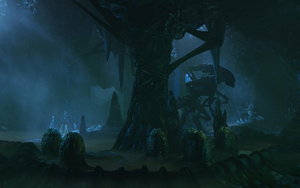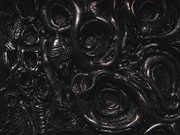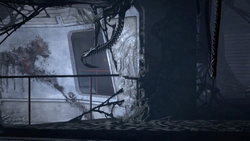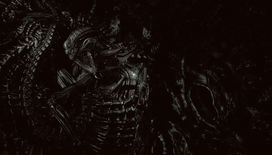No edit summary Tags: apiedit mobileedit |
(Undo revision 165936 by 73.184.215.137 (talk)) Tag: sourceedit |
||
| Line 10: | Line 10: | ||
Hives are built from a clear, gelatinous liquid that Xenomorph Drones vomit from their mouths<ref name="SOS274">{{cite book|title=''[[Alien: Sea of Sorrows]]''|author=[[James A. Moore]]|publisher=[[Titan Books]]|year=[[2014]]|page=274}}</ref> and eventually hardens to form a dark, strong, resinous substance, known as "[[Hive Webbing|webbing]]".<ref name="AWYR21">{{cite book|title={{AWYR}}|author=[[S. D. Perry]]|publisher=[[Insight Editions]]|year=[[2014]]|page=21}}</ref> This webbing is used to construct a warren-like maze of tunnels spreading outwards from a central Egg chamber, where the Queen will reside. It should be noted that while a Queen is typically found overseeing a Hive, one is not necessarily required for a Hive to form. Indeed, construction of a Hive may be a precursor to Queen development in many cases. In this respect, a Xenomorph Hive shares similarities in its architecture with both spider webs and wasp nests, while being directly comparable to neither. |
Hives are built from a clear, gelatinous liquid that Xenomorph Drones vomit from their mouths<ref name="SOS274">{{cite book|title=''[[Alien: Sea of Sorrows]]''|author=[[James A. Moore]]|publisher=[[Titan Books]]|year=[[2014]]|page=274}}</ref> and eventually hardens to form a dark, strong, resinous substance, known as "[[Hive Webbing|webbing]]".<ref name="AWYR21">{{cite book|title={{AWYR}}|author=[[S. D. Perry]]|publisher=[[Insight Editions]]|year=[[2014]]|page=21}}</ref> This webbing is used to construct a warren-like maze of tunnels spreading outwards from a central Egg chamber, where the Queen will reside. It should be noted that while a Queen is typically found overseeing a Hive, one is not necessarily required for a Hive to form. Indeed, construction of a Hive may be a precursor to Queen development in many cases. In this respect, a Xenomorph Hive shares similarities in its architecture with both spider webs and wasp nests, while being directly comparable to neither. |
||
| − | The primary purpose of the webbing is twofold — while it provides a surface to which potential hosts can be cocooned for implantation and birth, its non-uniform, bio-organic appearance also allows adult Xenomorphs to camouflage themselves when at rest, to the extent that humans have stood directly beside hiding [[Warrior]]s and had no idea of the imminent threat.<ref name="A2">{{cite video|people=[[James Cameron]] (writer and director)|title='{{A2}}'|medium=DVD|publisher=[[20th Century Fox]]|date=1986}}</ref> In the case of Hives set up inside existing non-Xenomorph structures, webbing helps to disguise existing visual cues in the environment, turning the area into a disorientating maze and making escape from and/or assaults on the Hive all the more difficult. However, whether this is considered by the Xenomorphs during construction is unclear. The |
+ | The primary purpose of the webbing is twofold — while it provides a surface to which potential hosts can be cocooned for implantation and birth, its non-uniform, bio-organic appearance also allows adult Xenomorphs to camouflage themselves when at rest, to the extent that humans have stood directly beside hiding [[Warrior]]s and had no idea of the imminent threat.<ref name="A2">{{cite video|people=[[James Cameron]] (writer and director)|title='{{A2}}'|medium=DVD|publisher=[[20th Century Fox]]|date=1986}}</ref> In the case of Hives set up inside existing non-Xenomorph structures, webbing helps to disguise existing visual cues in the environment, turning the area into a disorientating maze and making escape from and/or assaults on the Hive all the more difficult. However, whether this is considered by the Xenomorphs during construction is unclear. The structure of a Hive also appears to have a disrupting effect on motion tracker operation, generating a host of false readings that imply the entire area is awash with sporadic movement, making genuine readings harder to spot.<ref name="A2"/><ref name="AI">{{cite video|title='{{AI}}'|medium=Microsoft Windows, PlayStation 3, PlayStation 4, Xbox 360, Xbox One|publisher=[[Creative Assembly]]|date=2014}}</ref> The exact cause of this is unclear. |
The atmosphere within a Hive is typically very warm. A Queen will often locate her Hive in an area where these properties are already apparent, such as large industrial facilities where there is an abundance of ambient heat.<ref name="A2"/><ref name="AVP2010"/> It is also possible the Hive structure, or perhaps the resident Xenomorphs themselves, somehow raise atmospheric temperatures within the Hive to meet this requirement. |
The atmosphere within a Hive is typically very warm. A Queen will often locate her Hive in an area where these properties are already apparent, such as large industrial facilities where there is an abundance of ambient heat.<ref name="A2"/><ref name="AVP2010"/> It is also possible the Hive structure, or perhaps the resident Xenomorphs themselves, somehow raise atmospheric temperatures within the Hive to meet this requirement. |
||
Revision as of 23:21, 20 February 2016
| This article is about the Xenomorph nest. For the comic book, see Aliens: Hive. |

A Queen stalking through her Hive.
The Hive, also known as the Nest, is the nesting ground of a Xenomorph Queen, constructed from Hive Webbing, a gelatinous resin secreted by Drones. It is where the Queen will reside while she is laying Eggs, a state that renders her immobile, and is where those Eggs are subsequently stored. Potential hosts captured by other Xenomorphs are brought to the Hive and cocooned to the walls — a process sometimes referred to, particularly by Colonial Marines, as being "hived" [1] — to be implanted with Chestburster embryos.
Structure
- "Visibly damp and lustrous in spots, the peculiar material that had been used to construct the addition resembled a solidified liquid resin or glue. In places light penetrated the material to a depth of several centimitres, revealing a complex internal structure. At other locations the substance was opaque. What little color it dispalyed was muted: greens and grays, and here and there a touch of some darker green."
- ―Aliens novelization, chapter 7

Hive webbing.
Hives are built from a clear, gelatinous liquid that Xenomorph Drones vomit from their mouths[2] and eventually hardens to form a dark, strong, resinous substance, known as "webbing".[3] This webbing is used to construct a warren-like maze of tunnels spreading outwards from a central Egg chamber, where the Queen will reside. It should be noted that while a Queen is typically found overseeing a Hive, one is not necessarily required for a Hive to form. Indeed, construction of a Hive may be a precursor to Queen development in many cases. In this respect, a Xenomorph Hive shares similarities in its architecture with both spider webs and wasp nests, while being directly comparable to neither.
The primary purpose of the webbing is twofold — while it provides a surface to which potential hosts can be cocooned for implantation and birth, its non-uniform, bio-organic appearance also allows adult Xenomorphs to camouflage themselves when at rest, to the extent that humans have stood directly beside hiding Warriors and had no idea of the imminent threat.[4] In the case of Hives set up inside existing non-Xenomorph structures, webbing helps to disguise existing visual cues in the environment, turning the area into a disorientating maze and making escape from and/or assaults on the Hive all the more difficult. However, whether this is considered by the Xenomorphs during construction is unclear. The structure of a Hive also appears to have a disrupting effect on motion tracker operation, generating a host of false readings that imply the entire area is awash with sporadic movement, making genuine readings harder to spot.[4][5] The exact cause of this is unclear.
The atmosphere within a Hive is typically very warm. A Queen will often locate her Hive in an area where these properties are already apparent, such as large industrial facilities where there is an abundance of ambient heat.[4][1] It is also possible the Hive structure, or perhaps the resident Xenomorphs themselves, somehow raise atmospheric temperatures within the Hive to meet this requirement.
Size

Club Eden at the Freya's Prospect colony, turned into a small Hive by the Xenomorphs.
Hives can vary in size from extensive nests with hundreds of members headed by an Egg-laying Queen to small chambers occupied by only a few Drones or Warriors. Occasionally, in larger infestations, smaller "satellite" Hives will be set up in the areas surrounding the main nest. While these subsidiary Hives are occasionally used for the cocooning and impregnating of hosts, more often they are simply an outlying base of operations for Xenomorph Warriors.[1] Even individual Xenomorphs operating in isolation have been known to establish small nests,[6] although this is thought to be rare as a solitary creature has little need for a Hive of its own. The largest known Hive ever discovered is that on Xenomorph Prime, which covers half a continent.
Hive Node
- Main article: Hive Node
Hive nodes create the Alien life web. Drones carry dormant hive nodes in their stomach and using a gag reflex, release hive nodes on walls and on the ground. Once deposited the node uses up available organic materials from plants, carcasses, and even microorganisms to produce the hive's structure. This demonstrates the species' complete hostility toward all life forms. The life web slowly destroys the natural ecosystem of entire planets. If not in a fight an Alien can stand near a hive node and heal itself, making hive nodes a very valuable asset when infesting a planet. (Aliens versus Predator: Extinction)
Notable Hives

A Warrior Xenomorph camouflaged in the walls of the hive.

The Warrior moves in for the kill. The difference to this image to the one above is; the Warrior in the image above is remaining completely still so Colonial Marines can't pick them out of the hive webbing with their motion trackers. The Warrior in the second image is crawling through the hive webbing so marines can't see it moving closer. it will be read by the motion tracker but the marines won't see it in the camouflage.
A Hive was originally seen in Alien, when the Alien on board the Nostromo set up a nest in the ship's hold where it was converting its victims into new Eggs. However, this scene was ultimately cut from the theatrical release of the film, and consequently the first appearance of a Hive on film was in Aliens. The scene from Alien was reinstated in the 2003 Director's Cut.
Below is a list of notable Hives seen in various media from the Alien franchise.
- Aliens: A large Hive is set up within the Atmosphere Processing Plant at the Hadley's Hope colony on LV-426. It is ultimately destroyed when the Processor explodes.
- Aliens: Rogue: Several Xenomorphs were allowed to create a Hive in the uninhabited tunnels at Charon Base as part of Professor Ernst Kleist's research. The Hive, along with the rest of the base, was destroyed when an overloading Sound Cannon detonated in the Queen's chamber, obliterating the site.
- Alien Resurrection: The Cloned Queen sets up a Hive in a waste tank aboard the USM Auriga. It is destroyed when the Auriga explodes above Earth.
- Aliens versus Predator 2: The Xenomorphs left on LV-1201 set up a Hive in the Engineer ruins that grew in size over the thousands of years that followed. By the time the Weyland-Yutani team discovers the planet, the Hive has encompassed a good portion of the planet's surface. A smaller hive is set up in the Primary Operations Complex, but it is destroyed when Tomiko destroys the Weyland-Yutani complex. The primary Hive survives.
- Alien vs. Predator: Xenomorphs within the Yautja pyramid on Bouvet Island set up a small Hive in the structure's sacrificial chamber. It is destroyed by Scar's Self-Destruct Device.
- Predator: Concrete Jungle: A sizable Hive existed inside the Borgia Industries headquarters in Neonopolis, under the control of MOTHER, the supercomputer that ran the city. It was infiltrated by the Yautja known as Scarface and largely decimated, although many Xenomorphs survived the incident.
- Aliens vs. Predator: Requiem: The Gunnison Predalien establishes a small Hive inside the city's sewers, as well as a much larger one in the County Hospital. They were vaporised, along with the rest of the town, in a tactical nuclear strike.
- Aliens vs. Predator: The Matriarch on BG-386 sets up a Hive in the Freya's Prospect Refinery, as well as numerous smaller Hives throughout the colony and it's surroundings. The Matriarch was killed and the remaining structures on the planet apparently destroyed by a Yautja Self-Destruct Device.
- Aliens: Colonial Marines: Xenomorphs bred on LV-426 by Weyland-Yutani, led by a second Queen, set up a new Hive in the caves beneath the derelict ship and the ship itself. Separate Hives were also established in the sublevels of the derelict Hadley's Hope colony and aboard the USS Sulaco orbiting the moon. During a major Xenomorph outbreak, parts of the Origin Facility were also turned into a Hive. The Sulaco was later completely destroyed and the Queen on the surface was killed, but the Hives and many Xenomorphs remain on the moon.
- Alien: Isolation: The Alien aboard Sevastopol Station constructed a Hive in the lower engineering levels, where it entombed many of its victims and created numerous other Xenomorphs. The Hive was destroyed when Amanda Ripley overloaded the station's reactor, although several Xenomorphs escaped. Later, these escaped Xenomorphs began constructing a new Hive, but this too was destroyed when the station burnt up.
Behind the Scenes
The Hive scenes in Aliens were filmed at Acton Lane Power Station in West London. The Hive itself was first sculpted in clay and then moulded in latex and fiberglass pieces.[7] The set's construction was overseen by Peter Lamont.[8] While Acton Lane was being cleaned for asbestos, Lamont's effects team spent three weeks painting the individual Hive pieces, before they were transported to the now prepared power station and assembled.[7] The further three weeks set aside for construction proved just barely sufficient; while shooting was taking place on the lower floors, the upper floors were still being built. According to Lamont, "As Jim [Cameron] came up shooting, we were gradually retreating behind."[7] The cocooned victims trapped in the Hive were mostly portrayed by sculpted dummies with faces cast from actors.[7]
Appearances
- Alien Director's Cut/novel/comic
- Aliens/novel (First Appearance)
- Aliens: Book One
- Aliens: Theory of Alien Propagation
- Aliens: Book Two
- Aliens: Earth War/novel
- Aliens: Genocide/novel
- Alien Resurrection/novel
- Aliens: Berserker/novel
- Aliens versus Predator (video game)
- Aliens versus Predator 2/Primal Hunt
- Aliens versus Predator: Extinction (video game)
- Alien vs. Predator
- Predator: Concrete Jungle (video game)
- Aliens vs. Predator: Requiem
- Aliens vs. Predator (video game)
- Aliens: Infestation
- Aliens: Colonial Marines (video game)
- Alien: Isolation
References
- ↑ 1.0 1.1 1.2 Aliens vs. Predator (2010), Rebellion [Microsoft Windows, PlayStation 3, Xbox 360].
- ↑ James A. Moore. 'Alien: Sea of Sorrows', p. 274 (2014), Titan Books.
- ↑ S. D. Perry. 'Alien: The Weyland-Yutani Report', p. 21 (2014), Insight Editions.
- ↑ 4.0 4.1 4.2 James Cameron (writer and director). Aliens (1986), 20th Century Fox [DVD].
- ↑ Alien: Isolation (2014), Creative Assembly [Microsoft Windows, PlayStation 3, PlayStation 4, Xbox 360, Xbox One].
- ↑ Dan O'Bannon, Ronald Shusett (writers) and Ridley Scott (director). Alien Director's Cut (2003), 20th Century Fox [DVD].
- ↑ 7.0 7.1 7.2 7.3 "Monster Legacy - StarBeast — Part IIa: Aliens". Retrieved on 2015-02-24.
- ↑ Jody Duncan. 'The Winston Effect: The Art and History of Stan Winston Studio', p. 88 (2006), Titan Books.
